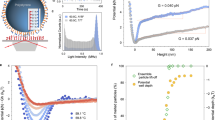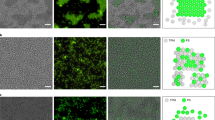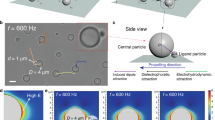Abstract
Surface functionalization with DNA is a powerful tool for guiding the self-assembly of nanometre- and micrometre-sized particles1,2,3,4,5,6,7,8,9,10,11. Complementary ‘sticky ends’ form specific inter-particle links and reproducibly bind at low temperature and unbind at high temperature. Surprisingly, the ability of single-stranded DNA to form folded secondary structures has not been explored for controlling (nano) colloidal assembly processes, despite its frequent use in DNA nanotechnology12,13,14. Here, we show how loop and hairpin formation in the DNA coatings of micrometre-sized particles gives us in situ control over the inter-particle binding strength and association kinetics. We can finely tune and even switch off the attractions between particles, rendering them inert unless they are heated or held together—like a nano-contact glue. The novel kinetic control offered by the switchable self-protected attractions is explained with a simple quantitative model that emphasizes the competition between intra- and inter-particle hybridization, and the practical utility is demonstrated by the assembly of designer clusters in concentrated suspensions. With self-protection, both the suspension and assembly product are stable, whereas conventional attractive colloids would quickly aggregate. This remarkable functionality makes our self-protected colloids a novel material that greatly extends the utility of DNA-functionalized systems, enabling more versatile, multi-stage assembly approaches.
This is a preview of subscription content, access via your institution
Access options
Subscribe to this journal
Receive 12 print issues and online access
$259.00 per year
only $21.58 per issue
Buy this article
- Purchase on Springer Link
- Instant access to full article PDF
Prices may be subject to local taxes which are calculated during checkout





Similar content being viewed by others
References
Maye, M. M., Nykypanchuk, D., van der Lelie, D. & Gang, O. DNA-regulated micro- and nanoparticle assembly. Small 3, 1678–1682 (2007).
Mirkin, C. A., Letsinger, R. L., Mucic, R. C. & Storhoff, J. J. A DNA-based method for rationally assembling nanoparticles into macroscopic materials. Nature 382, 607–609 (1996).
Tkachenko, A. V. Morphological diversity of DNA-colloidal self-assembly. Phys. Rev. Lett. 89, 148303 (2002).
Licata, N. A. & Tkachenko, A. V. Errorproof programmable self-assembly of DNA-nanoparticle clusters. Phys. Rev. E 74, 041406 (2006).
Biancaniello, P. L., Kim, A. J. & Crocker, J. C. Colloidal interactions and self-assembly using DNA hybridization. Phys. Rev. Lett. 94, 058302 (2005).
Nykypanchuk, D., Maye, M. M., van der Lelie, D. & Gang, O. DNA-guided crystallization of colloidal nanoparticles. Nature 451, 549–552 (2008).
Park, S. Y. et al. DNA-programmable nanoparticle crystallization. Nature 451, 553–556 (2008).
Kim, A. J., Scarlett, R., Biancaniello, P. L., Sinno, T. & Crocker, J. C. Probing interfacial equilibration in microsphere crystals formed by DNA-directed assembly. Nature Mater. 8, 52–55 (2009).
Xiong, H., van der Lelie, D. & Gang, O. Phase behavior of nanoparticles assembled by DNA linkers. Phys. Rev. Lett. 102, 015504 (2009).
Milam, V. T., Hiddessen, A. L., Crocker, J. C., Graves, D. J. & Hammer, D. A. DNA-driven assembly of bidisperse, micron-sized colloids. Langmuir 19, 10317–10323 (2003).
Valignat, M. P., Theodoly, O., Crocker, J. C., Russel, W. B. & Chaikin, P. M. Reversible self-assembly and directed assembly of DNA-linked micrometer-sized colloids. Proc. Natl Acad. Sci. USA 102, 4225–4229 (2005).
Yurke, B., Turberfield, A. J., Mills, A. P. J., Simmel, F. C. & Neumann, J. L. A DNA-fuelled molecular machine made of DNA. Nature 406, 605–608 (2000).
Yan, H., Zhang, X., Shen, Z. & Seeman, N. C. A robust DNA mechanical device controlled by hybridization topology. Nature 415, 62–65 (2002).
Aldaye, F. A., Palmer, A. L. & Sleiman, H. F. Assembling materials with DNA as the guide. Science 321, 1795–1799 (2008).
Jin, R., Wu, G., Li, Z., Mirkin, C. A. & Schatz, G. C. What controls the melting properties of DNA-linked gold nanoparticle assemblies? J. Am. Chem. Soc. 125, 1643–1654 (2003).
Nykypanchuk, D., Maye, M. M., van der Lelie, D. & Gang, O. DNA-based approach for interparticle interaction control. Langmuir 23, 6305–6314 (2007).
Dreyfus, R. et al. Simple quantitative model for the reversible association of DNA coated colloids. Phys. Rev. Lett. 102, 048301 (2009).
Bonnet, G., Krichevsky, O. & Libchaber, A. Kinetics of conformational fluctuations in DNA hairpin-loops. Proc. Natl Acad. Sci. USA 95, 8602–8606 (1998).
Baudry, J. et al. Acceleration of the recognition rate between grafted ligands and receptors with magnetic forces. Proc. Natl Acad. Sci. USA 103, 16076–16078 (2006).
Grier, D. G. A revolution in optical manipulation. Nature 424, 810–816 (2003).
Roichman, Y., Sun, B., Roichman, Y., Amato-Grill, J. & Grier, D. G. Optical forces arising from phase gradients. Phys. Rev. Lett. 100, 013602 (2008).
Schmatko, T. et al. A finite-cluster phase in λ-DNA-coated colloids. Soft Matter 3, 703–706 (2007).
Smoluchowski, M. V. Versuch einer mathematischen theorie der koagulationskinetik kolloider lösungen. Z. Phys. Chem. 92, 129–168 (1917).
Dimitrov, R. A. & Zuker, M. Prediction of hybridization and melting for double-stranded nucleic acids. Biophys. J. 87, 215–226 (2004).
Crocker, J. C. Nanomaterials: Golden handshake. Nature 451, 528–529 (2008).
Cordier, P., Tournilhac, F., Soulie-Ziakovic, C. & Leibler, L. Self-healing and thermoreversible rubber from supramolecular assembly. Nature 451, 977–980 (2008).
von Andrian, U. H. et al. Two-step model of leukocyte endothelial cell interaction in inflammation: Distinct roles for LECAM-1 and the leukocyte β2 integrins in vivo. Proc. Natl Acad. Sci. USA 88, 7538–7542 (1991).
Caruthers, M. H. Gene synthesis machines: DNA chemistry and its uses. Science 230, 281–285 (1985).
Zuker, M. Mfold web server for nucleic acid folding and hybridization prediction. Nucleic Acids Res. 31, 3406–3415 (2003).
Zuker, M. <http://mfold.bioinfo.rpi.edu/>.
Leunissen, M. E. et al. Towards self-replicating materials of DNA-functionalized colloids. Soft Matter 10.1039/B817679E (2009).
Acknowledgements
We thank D. J. Pine and M. Zuker for useful discussions. This work was supported partially by the MRSEC Program of the National Science Foundation under Award Number DMR-0820341, by the Keck Foundation and the Netherlands Organisation for Scientific Research (NWO).
Author information
Authors and Affiliations
Contributions
M.E.L. carried out the experiments, theoretically modelled the data and wrote the manuscript. R.D. was involved in setting up the experiments and the development of the model, F.C.C. and D.G.G. participated in the optical laser tweezer experiments, R.S. and N.C.S. synthesized DNA and P.M.C. supervised the research. Everybody contributed important conceptual insight.
Corresponding author
Supplementary information
Supplementary Information
Supplementary Information (PDF 480 kb)
Supplementary Information
Supplementary Movie 1 (MPG 1266 kb)
Supplementary Information
Supplementary Movie 2 (MPG 1398 kb)
Supplementary Information
Supplementary Movie 3 (MPG 3302 kb)
Supplementary Information
Supplementary Movie 4 (MPG 1258 kb)
Supplementary Information
Supplementary Movie 5 (MPG 1440 kb)
Supplementary Information
Supplementary Movie 6 (MPG 672 kb)
Rights and permissions
About this article
Cite this article
Leunissen, M., Dreyfus, R., Cheong, F. et al. Switchable self-protected attractions in DNA-functionalized colloids. Nature Mater 8, 590–595 (2009). https://doi.org/10.1038/nmat2471
Received:
Accepted:
Published:
Issue Date:
DOI: https://doi.org/10.1038/nmat2471
This article is cited by
-
Crystal engineering with DNA
Nature Reviews Materials (2019)
-
Magnetically tunable bidirectional locomotion of a self-assembled nanorod-sphere propeller
Nature Communications (2018)
-
Volume and porosity thermal regulation in lipid mesophases by coupling mobile ligands to soft membranes
Nature Communications (2015)
-
Nanocapillarity-mediated magnetic assembly of nanoparticles into ultraflexible filaments and reconfigurable networks
Nature Materials (2015)
-
Crowding-induced Cooperativity in DNA Surface Hybridization
Scientific Reports (2015)



